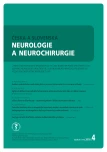Bilateral abducens nerve palsy after head and cervical spinal injury
Authors:
M. Bolcha; P. Vachata; M. Sameš
Authors‘ workplace:
Neurochirurgická klinika, Univerzita J. E. Purkyně a Masarykova nemocnice Ústí nad Labem
Published in:
Cesk Slov Neurol N 2018; 81(4): 481-483
Category:
Letters to Editor
doi:
https://doi.org/10.14735/amcsnn2018481
Overview
The authors declare they have no potential conflicts of interest concerning drugs, products,or services used in the study.
The Editorial Board declares that the manu script met the ICMJE “uniform requirements” for biomedical papers.
Sources
1. Dolenc VV. Microsurgical anatomy and surgery of the central skull base. In: Paraclival region, inferomedial triangle. Wien: Springer-Verlag Wien 2003 : 29 – 31.
2. Kshettry VR, Lee JH, Ammirati M. The Dorello canal: historical development, controversies in microsurgical anatomy, and clinical implications. Neurosurg Focus 2013; 34(3): E4. doi: 10.3171/ 2012.11.FOCUS12344.
3. Fam DJ, Baharnoori M, Kassardjian CD et al. Posttraumatic bilateral abducens nerve palsy: mechanism of injury and prognosis. Can J Neurol Sci 2015; 42(5): 344 – 346. doi: 10.1017/ cjn.2015.57.
4. Schneider RC, Johnson FD. Bilateral traumatic abducens palsy. A mechanism of injury suggested by the study of associated cervical spine fractures. J Neurosurg 1971; 34(1): 33 – 37.
5. Takagi H, Miyasaka Y, Kuramae T et al. Bilateral traumatic abducens nerve palsy without skull fracture or intracranial hematoma-a report of 3 cases and consideration of the mechanism of injury (author‘s transl). No Shinkei Geka 1976; 4(10): 963 – 969.
6. Garton HJ, Gebarski SS, Ahmad O et al. Clival epidural hematoma in traumatic sixth cranial nerve palsies combined with cervical injuries. J Neuroophthalmol 2010; 30(1): 18 – 25. doi: 10.1097/ WNO.0b013e3181ce14ae.
7. Dengler BA, Bartanusz V. Bilateral abducens nerve palsy following ligamentous C1 – C2 distraction. Eur Spine J 2014; 23 (Suppl 2): 248 – 252. doi: 10.1007/ s00586-013-3121-x.
8. Uzan M, Hanci M, Sarioğlu AC et al. Bilateral traumatic abducens nerve paralysis with cervical spine flexion injury. Eur Spine J 1996; 5(4): 275 – 277.
9. Lee SJ, Yang HK, Ji MJ et al. Delayed unilateral abducens nerve palsy following contralateral post-traumatic epidural hematoma. Br J Neurosurg 2016; 30(1): 120 – 121. doi: 10.3109/ 02688697.2015.1073221.
10. Koskela E, Laakso A, Kivisaari R et al. Eye movement abnormalities after a ruptured intracranial aneurysm. World Neurosurg 2015; 83(3): 362 – 367. doi: 10.1016/ j.wneu.2014.04.059.
Labels
Paediatric neurology Neurosurgery NeurologyArticle was published in
Czech and Slovak Neurology and Neurosurgery

2018 Issue 4
- Memantine in Dementia Therapy – Current Findings and Possible Future Applications
- Metamizole vs. Tramadol in Postoperative Analgesia
- Metamizole at a Glance and in Practice – Effective Non-Opioid Analgesic for All Ages
- Memantine Eases Daily Life for Patients and Caregivers
- Advances in the Treatment of Myasthenia Gravis on the Horizon
Most read in this issue
- Antiplatelet and anticoagulant therapy in carotid endarterectomies
- Bilateral abducens nerve palsy after head and cervical spinal injury
- Imaging of peripheral nerves using diffusion tensor imaging and MR tractography
- Late-onset Huntington’s disease – an overlooked diagnosis
